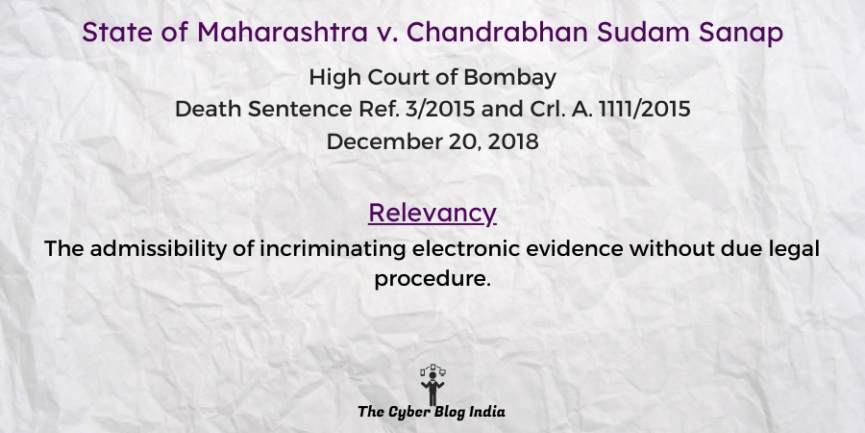State of Maharashtra v. Chandrabhan Sudam Sanap

State of Maharashtra v. Chandrabhan Sudam Sanap
2019 ALLMR (Cri) 2889
In the High Court of Bombay
Death Sentence Ref. 3/2015 and Crl. A No. 1111/2015
Before Justice Ranjit V. More and Justice Bharati H. Dangre
Decided on December 20, 2018
Relevancy of the case: The admissibility of incriminating electronic evidence without due legal procedure.
Statutes & Provisions Involved
- The Information Technology Act, 2000 (Section 2(t), 2(o))
- The Indian Penal Code, 1860 (Section 364, 366, 376(2)(m), 376(A), 392 r/w Section 397, 302, 201, 170)
- The Code of Criminal Procedure, 1973 (Section 28(2), 313, 273)
- The Indian Evidence Act, 1872 (Section 65A, 65B)
- The Railways Act, 1989 (Section 147)
Relevant Facts of the Case
- The deceased, Esther, was traveling from Visakhapatnam to Mumbai. Subsequently, she went missing after replying to her father, the complainant, that she reached Solapur. Hence, upon receiving no further reply, her father filed a missing complaint.
- Upon investigation, the authorities found the deceased; with her burnt body. After they handed her to her father, the post-mortem report revealed blunt injuries to the body and genitals.
- Furthermore, an investigation of the CCTV footage of nearby cameras revealed a Chandrabhan Sanap, the accused, accompanying the deceased. Subsequently, the police arrested the accused and filed a chargesheet on the accounts of rape and murder.
- Thus, the trial court convicted the accused for the offenses punishable under Sections 302, 364, 366, 376(2)(m), 376A, 392 r/w Section 397 and 201 of the IPC. Consequently, along with a sentence of life imprisonment and compensation, the judge sentenced the accused to death.
- Hence, the accused appealed the trial court’s order before the High Court.
Prominent Arguments by the Advocates
- The Special Public Prosecutor submitted that the prosecution had established the circumstances pointing to the accused’s guilt, based on the evidence brought on record.
- Moreover, the evidence of record, in the form of CCTV footage, is the main incriminating evidence since the perpetrator was the last person seen with the victim.
- The accused’s counsel submitted that the prosecution failed to prove the guilt of the accused beyond a reasonable doubt.
- Furthermore, the electronic evidence cannot be proved in accordance with the terms under Section 65B of the Indian Evidence Act. The footage was handed over to the investigating officer through a pen drive.
Opinion of the Bench
- The bench noted that per State (NCT of Delhi) v. Navjot Sandhu, for an electronic record to be admissible, the certificate under Section 65B must be produced.
- However, per Anvar v. Basheer, the bench observed that the procedural requirement under Section 65B(4) of furnishing a certificate can apply only if a person in a position to produce such certificate of the incriminating electronic evidence when he/she is in control of the said device.
- Consequently, the bench noted that if a party does not possess the said device, the Court cannot exclude the applicability of sections 63 and 65 of the Evidence Act. Moreover, the Court can relax the applicability of the procedural requirement for the certificate in the interest of justice.
- Hence, the bench found no merit in the accused’s counsel’s argument on the admissibility of the CCTV footage.
Final Decision
- The bench thus affirmed the conviction and the death sentence of the accused, thereby dismissing the appeal.
To read this case summary in English, click here. | इस केस सारांश को हिंदी में पढ़ने के लिए यहाँ क्लिक करें।
As per our guidelines, we have removed certain information that falls under the category of personally identifiable information (PII). The said guideline is available here.
https://cyberblogindia.in/wp-content/uploads/2020/06/Case-Summaries-Removal-of-Personally-Identifiable-Information-Version-1.0-June-06-2020.pdf
